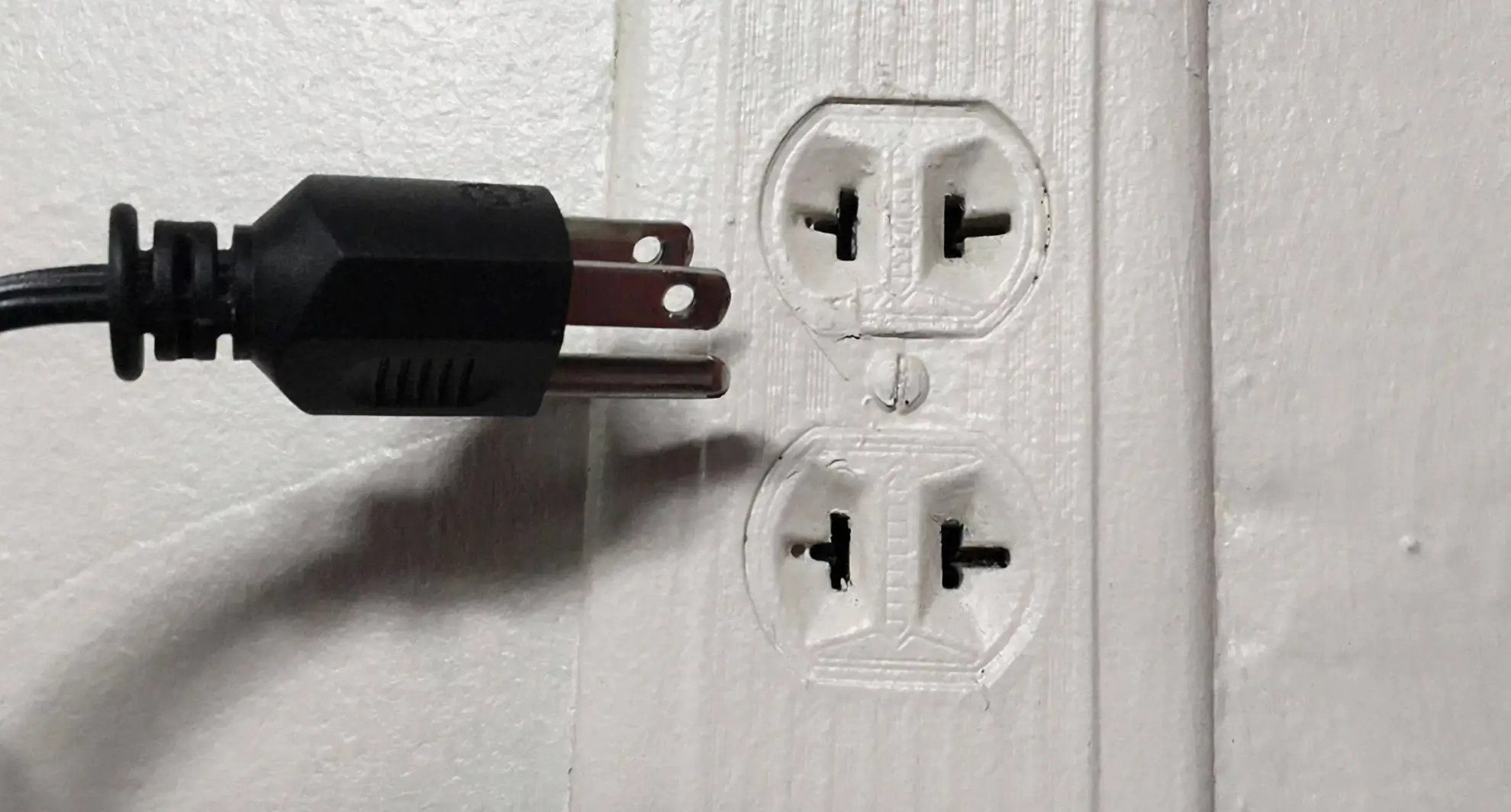
Mr. Electric Explains How to Replace a Two-Prong Outlet with a Three-Prong Outlet
|
Are you ready to upgrade your two-prong outlets with safer and more versatile three-prong receptacles? This comprehensive guide will help you learn about changing a two-prong outlet to three. Whether planning a full electrical overhaul or upgrading a single outlet, here are the answers you need.
Why It Matters: From Vintage to Versatile
For decades, two-prong receptacles were the standard household outlet, but this has changed. They can still be used by many appliances today; however, they lack grounding, a critical safety feature that protects against electrical faults and accidental shocks. In today’s gadget-filled homes, where every plug may carry high-tech, high-wattage potential, grounding isn’t just a luxury—it’s essential.
Grounded (3-prong) outlets, on the other hand:
- Protect sensitive electronics from interference.
- Reduce the risk of electric shock.
- Avoid fused plugs and adapters.
- Meet building codes for health and resale value.
Switching a 2-prong outlet to a 3-prong outlet is more than an upgrade—it’s a modernization that enhances your home’s safety.
How Electricians Replace a Two-Prong with a Three-Prong GFCI Outlet Without a Ground Wire
Changing a two-prong outlet to three-prongs isn't necessarily as easy as swapping out one box for another. Why? Two-prong outlets lack a ground wire, creating an increased risk of electrocution and appliance damage. Simply swapping in an outlet with an additional prong will allow you to plug in 3-pronged appliances, but it will not provide the safety that grounding offers.
If you’re in an older home, upgrading your wiring offers the safest means of upgrading to three-prong outlets; however, it may not be feasible for renters or those with shared walls. Less intrusive means of upgrading to a grounded outlet include adding a ground wire or installing a GFCI outlet. All of these options should be handled by a professional electrician.
Adding a ground wire
This solution involves running a ground wire from the main panel or a grounded junction box to each outlet you wish to upgrade. While adding a ground wire to your existing wiring provides a permanent and reliable solution, this is a project that should only be handled by a qualified professional.
Installing a GFCI outlet
GFCI outlets provide a grounded receptacle without rewiring or running a new ground wire to the electrical panel. Here’s how:
-
After turning off the power at the panel, your electrician will confirm that no electricity is flowing at the outlet using a multimeter.
-
Your electrician will remove the plate screw and cover, as well as the two screws holding the old receptacle in the box.
-
The old outlet box is pulled out without cracking the wiring, then gently extended to gain access to the wires.
-
The old outlet is disconnected.
-
Some old boxes are tight. If the GFCI outlet doesn’t fit, a new, larger electrical box may be needed.
-
-
If the wires aren’t long enough, your electrician may add a 4–6" extension (called a “pigtail”) using the appropriate wire for the circuit amperage.
- 15 amp = 14 gauge
- 20 amp = 12 gauge
-
The wires are connected to the “Line” terminals on the GFCI.*
- The black (hot) wire connects to the brass terminal.
- The white (neutral) wire connects to the silver terminal.
-
Wires are carefully tucked into the box and the receptacle is screwed into place.
-
Once the faceplate is secured and the power turned on, the GFCI is tested using the Test and Reset buttons.
-
A “No Equipment Ground” sticker is required to identify the upgraded outlet.
*GFCI units have “Line” and “Load” terminals. Line terminals receive current from the electrical panel, while Load terminals facilitate current leaving the GFCI to “downline” outlets. When upgrading from a 2-pronged outlet, only the Line terminals will be used.
Note: Switching from a two-prong outlet to an ungrounded three-prong GFCI protects you from electric shock, but it will not provide the necessary ground protection that prevents sensitive electronics from being fried during voltage fluctuations.
To meet NEC code and maintain the safety of both yourself and your electronics, we do not recommend installing ungrounded three-prong outlets.
When to call in the experts
While upgrading to a 3-prong outlet with a GFCI upgrade is not a complex process, it requires working with electrical components and should only be handled by a qualified professional. Contact an electrician in the following circumstances:
- No ground wire exists.
- You want smart or voice-controlled outlets.
- You’re unsure about circuit conditions.
- Multiple outlets need upgrades.
- You want a full inspection or panel upgrade.
Ready to Plug Into Peace of Mind?

Upgrading from two-prongs to three might sound like a simple project, but it’s a transformative leap in safety, code compliance, and plug usage. Whether you're replacing a single outlet or modernizing an entire space, it’s a worthwhile endeavor.
Mr. Electric® provides expert electrical outlet installation and GFCI upgrades. If you're ready to convert a two-prong outlet to three in your home or business, contact your local Mr. Electric team for professional installation that brings your electrical system up to modern safety standards.
This article is intended for general guidance only and is not applicable to every situation. You are responsible for determining the proper course of action for your property and situation. Mr. Electric is not responsible for any damages that occur as a result of advice and/or guidance derived from its blog content.
FAQs About Upgrading to a Three-Pronged Outlet
The safety of you, your family, and your home are the top priority of every Mr. Electric service professional. Our safety-first commitment to solving your electrical issues includes a meticulous attention to detail on every job. Our commitment also includes using our years of experience to answer your questions. Below are answers to some of the most frequently asked questions about replacing two-prong with three-prong outlets.
Is changing a two-prong outlet to three important for safety?
Yes, changing a two-prong outlet to a three-prong outlet helps protect both your electronics and your household. Two-prong outlets lack a grounding path, which means that in the event of a fault or surge, the excess electricity has nowhere safe to go. This can result in shocks, equipment damage, or even fires. Today’s building codes require grounded (3-pronged) outlets for good reason—they improve personal safety and protect sensitive devices like computers and TVs.
How do electricians switch a 2-prong outlet to 3-prong while meeting code?
When professionals switch a 2-prong outlet to 3-prong, they begin by checking if a grounding wire is present. If one exists, they connect it to a grounded three-prong outlet. If not, they may install a GFCI outlet that protects users even without grounding—though this must be labeled “No Equipment Ground.” In more comprehensive updates, the electrician may run new wiring or install a grounding trunkline. Regardless of method, each installation is tested to ensure proper grounding, code compliance, and functionality.
Can I convert a two-prong outlet to three on my own?
Attempting to convert to a three-prong outlet without proper training can lead to serious hazards, including electric shock, non-compliance with code, or incorrect grounding that creates a false sense of safety. Even using plug adapters with grounding tabs is unsafe if the outlet box itself isn’t grounded. It's always best to hire a professional to evaluate your wiring and install grounded or GFCI outlets with the correct safety markings and labels.
How do I change outlets in older homes with no grounding?
Many homes built before the 1960s may not have grounding conductors at all. In these cases, you can’t simply swap out two-prong outlets for three-prong models without addressing the lack of ground. The safe solution is to either install GFCI outlets with proper labeling or rewire the circuit with a ground wire. Each approach requires detailed testing and expert knowledge to ensure the result is safe and code-compliant.
How can I keep outlets safe in an older house?
Beyond changing a two-prong outlet to a three-prong, there are other steps you can take to increase safety. Living in an older home doesn’t mean you’re stuck with unsafe wiring—but it does mean you need to stay alert. If you’re holding off on a full upgrade, you can still reduce your risk with a few simple steps:
- Try not to plug multiple energy-hungry appliances—like space heaters and window A/C units—into the same circuit. Spread them out to avoid overloading.
- Schedule a licensed electrician to perform a routine checkup every few years, especially if you’ve added new tech or noticed flickering lights.
- Make sure cords and outlets remain dry, especially in kitchens, bathrooms, and basements where GFCI outlets aren’t available.
- Finally, don’t ignore signs of wear—if a cord is cracked, brittle, or frayed, it’s time to repair or replace it before it becomes a hazard.

